|
|
 |
Baked Eggnog Cheesecake—Prototype 1:
Crust:
4 oz. whipped lowfat cottage cheese
3 tablespoons granulated sugar
1/4 teaspoon vanilla
1/4 teaspoon cinnamon
1/8 teaspoon nutmeg
1/8 teaspoon rum extract (such as McCormick)
2 tablespoons light eggnog (such as Hood)
Thoroughly blend these above 7 ingredients together. Afterward, quickly and
vigorously mix in:
2.2 oz. finely ground Bran Buds
Press this resulting mixture into the bottom of a lightly buttered 9"
cheesecake pan.
Batter:
2 cups lowfat cottage cheese
2 tablespoons melted or softened butter
2 eggs
1/2 cup granulated sugar
3/4 cup light eggnog (such as Hood)
1/3 cup flour
1/2 teaspoon salt
1 teaspoon lemon juice
Blend all these ingredients together thoroughly, particularly the butter and
eggs, then pour this batter into the pan, on top of the crust. Promptly
place this into the oven—preheated at 300 degrees—and bake for 100 minutes
(or until cake tester comes out clean). Remove from oven, cool down to about
room temperature (about 1 1/2 hours), carefully remove from pan, and chill.
Baked Eggnog Cheesecake—Prototype 2:
Repeat Prototype 1, but make these changes for the batter:
Boost eggnog by 3/4 cup, to 1 1/2 cups.
Boost flour by 1/6 cup, to 1/2 cup (to help compensate for the increase in
liquid).
Baked Eggnog Cheesecake—Prototype 3:
Repeat Prototype 2, but make these changes for the batter:
Boost eggnog by 1/2 cup, to 2 cups.
Add 1 tablespoon of rum extract (yes, that is a generous amount).
Add 1/8 teaspoon of nutmeg.
Also, let's make the crust a little tastier. Combine 1 tablespoon of brown
sugar with the crust's earlier ingredients (i.e., before blending in the
Bran Buds).
Baked Eggnog Cheesecake—Prototype 4:
Repeat Prototype 3, but make these changes for the batter:
Boost nutmeg by 3/8 teaspoon, to 1/2 teaspoon (thus adding more spice).
Boost flour by 1 tablespoon, to 1/2 cup plus 1 tablespoon (for the sake of
firmness, to compensate for the liquid increases in Prototype 3).
Baked Eggnog Cheesecake—Prototype 5:
Okay, repeat Prototype 4, but decrease the batter's rum extract from 1
tablespoon to only 2/3 (i.e., from 3 teaspoons to only 2).
Baked Eggnog Cheesecake—Prototype 6:
Spice it up a little more! Repeat Prototype 5, and boost the batter's nutmeg
by 1/2 teaspoon to 1 full teaspoon.
Baked Eggnog Cheesecake—Prototype 7:
Repeat Prototype 6, but spice up the batter even more by adding 1 teaspoon
of cinnamon to it. Also increase the moisture and flavor for the crust by
boosting its eggnog from 2 tablespoons to 1/2 cup (with this change,
the crust mixture becomes somewhat pour-able, subject to the timing of
blending in the Bran Buds, so be sure to let this mixture firm up a little
in the pan before adding the batter on top).
Baked Eggnog Cheesecake—Prototype 8:
Okay—repeat Prototype 6 again, but reduce the batter's rum extract from 2
to 1 + 1/2 teaspoons (in other words, to put it simply, 1/2 tablespoon). For
this prototype, skip the crust.
Baked Eggnog Cheesecake—Prototype 9:
Repeat Prototype 8, and increase the batter's flour from 1/2 cup + 1
tablespoon (that's 9 tablespoons) to 3/4 cup (that's 12
tablespoons—therefore the flour is getting about a 33% boost). No crust.
Where are we at this point with the baked eggnog cheesecake
prototypes??
Okay, I felt that at this point, I should provide the details of the ingredients
so far—plus sequential info. This is batter-only (no crust).
Grease a 9" springform pan. For best results take the bath
approach—wrap this pan up to the sides with foil, in order to suppress
water leaks (heavy-duty aluminum is a good choice).
Mix thoroughly together:
2 tablespoons butter, softened or melted
1/2 cup granulated sugar
Then blend in:
1 teaspoon lemon juice
1/2 tablespoon rum extract
Then mix in:
2 cups (such as a 16-ounce container) of lowfat cottage cheese (such as
Hood, no salt added)—whip this in a blender just until the curds no
longer show, before adding to the above ingredients.
Next add:
2 cups of light eggnog (such as Hood or Oakhurst)
Follow up gradually with a dry combination of:
3/4 cup flour
1/2 teaspoon salt
1 teaspoon nutmeg
Completely mix all of the above ingredients used so far, then finally add:
2 eggs (last ingredient here)—aim to get these at least fully mixed
in (yet without overbeating, if possible).
Have enough boiling hot water available at this point if using the bath
approach (if the water is cold, the baking is going to get off to a start
that's too cold!), and pour some into a large pan—let's call this the
"tub".
Also, the oven should be preheated to 300 degrees.
Pour the batter into the springform pan. No bath? Then put the pan directly
into the oven. But for the bath approach, place this pan into the
"tub", add more hot water (perhaps to the batter's height), and
put the whole thing into the oven. Bake for about 100 minutes.
Afterward, take the springform pan out of the oven (and out of the
"tub" if applicable) for the cooldown.
Baked Eggnog Cheesecake—Prototype 10:
Okay, let's give the crust another try. Its ingredient list at this point is
as follows, with the latest changes noted:
4 oz. whipped lowfat cottage cheese
3 tablespoons granulated sugar
1 tablespoon brown sugar
1/4 teaspoon vanilla
1/4 teaspoon cinnamon
1/4 teaspoon nutmeg (up from 1/8 teaspoon, for more flavor)
1/4 teaspoon rum extract (up from 1/8 teaspoon, for more flavor)
1/4 cup light eggnog (that's 4 tablespoons, a reasonable compromise
between 2 tablespoons and 1/2 cup)
2.2 oz. finely ground Bran Buds
For the sake of flavor, the increase in the nutmeg and rum extract seemed
like a reasonable compensation for the decrease in eggnog from its 1/2 cup
usage in Prototype 7.
For the batter, repeat Prototype 9, but in light of the questionable need
for salt—combined with a desire to cut down what seemed to be unnecessary
sodium, reduce the salt from 1/2 teaspoon to 1/4 teaspoon (seemed like a
reasonable compromise, in case the recipe still needed some salt).
Use the bath approach on this one, foil and all.
Baked Eggnog Cheesecake—Prototype 11:
Seems like maybe a little too much emphasis has been placed on the
"eggnog" in "eggnog cheesecake" (and too little on
"cheesecake"). This prototype is slightly mellower and sweeter.
So repeat Prototype 10, but make these changes for the batter:
Boost granulated sugar by 1/6 cup, to 2/3 cup.
Decrease rum extract by 1/2 teaspoon, to 1 teaspoon.
Add 1 teaspoon of vanilla extract (include this one when blending in the
lemon juice and rum extract).
Remember that only 1/4 teaspoon of salt is to be used here (not 1/2
teaspoon).
As for the bath approach, instead of placing the springform pan directly in
the hot "tub", put it immediately above it, preferably by
using a grate between the two (the "tub" itself being placed close
to halfway up in the oven).
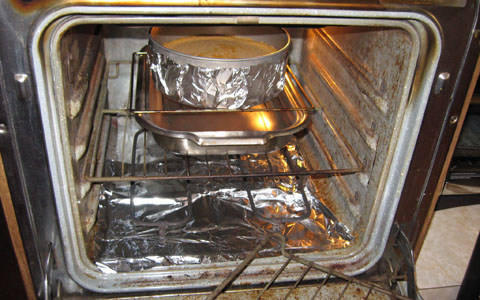
In order to prevent steam from rising up into the bottom of the cheesecake's
pan, it is still advisable to wrap a piece of foil around its bottom.
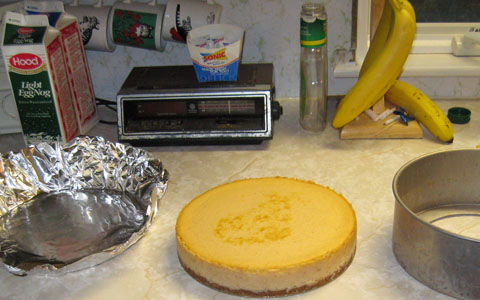
Baked Eggnog Cheesecake—Prototype 12:
Crust:
1.5 oz. melted, white chocolate
1/2 cup (4 oz.) lowfat cottage cheese, whipped, no salt added
1 teaspoon lemon juice
2 tablespoons granulated sugar
3 tablespoons brown sugar
2 teaspoons cinnamon
1/2 teaspoon vanilla
2.2 oz. Bran Buds, ground up
Batter:
2 tablespoons butter, softened or melted
2/3 cup granulated sugar
1 tablespoon lemon juice
1/2 tablespoon rum extract
1 teaspoon vanilla extract
2 1/2 cups (20 oz.) whipped lowfat cottage cheese, no salt added
2 cups of light eggnog
1 cup flour
1/4 teaspoon salt
1/2 teaspoon nutmeg
2 eggs
Bake in (not above!) a tub at 300 degrees for about 2 hours,
then remove from oven, and let this cheesecake cool off for about 2 hours
before removing from pan.
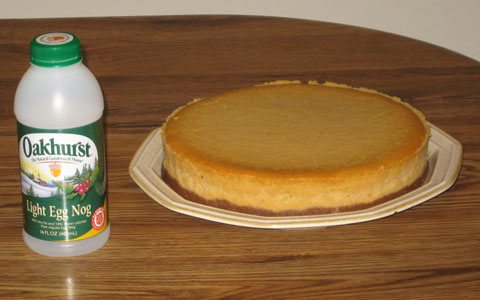
Baked Eggnog Cheesecake—Prototype 13:
Repeat Prototype 12, but replace the crust's 1/2 cup of lowfat cottage
cheese with 1/2 cup of light eggnog.
Also, bake this cheesecake for about 110 minutes (instead of 120). Continue
doing it "in-the-tub" style ("in" is here
to stay at this point—just be careful with that foil, disturbing it as
little as possible: gently wrap it onto the pan immediately before placing
the cheesecake into the bath for baking, not earlier—first grease the pan,
then "crust" it, then pre-bake it [if applicable—but use no tub
during this phase], then cool it, then "batter" it, then
"foil" it, then "tub-and-bake" it). Got it?
Baked Eggnog Cheesecake—Prototype 14:
Repeat Prototype 13, but reduce the batter's rum extract by 1/2 teaspoon,
back to only 1 teaspoon.
Also, after the crust has been placed into the pan, pre-bake it (no tub
during this phase) for about 20 minutes at 300 degrees, then cool it off
until it can be comfortably touched. Add the batter afterward and bake (in a
tub at this point) for about 110 minutes.
Baked Eggnog Cheesecake—Prototype 15:
So where are we at now?
Crust:
1.5 oz. melted, white chocolate
1/2 cup light eggnog
1 teaspoon lemon juice
2 tablespoons granulated sugar
3 tablespoons brown sugar
2 teaspoons cinnamon
1/2 teaspoon vanilla
2.2 oz. Bran Buds, ground up
Pre-bake, no tub, for about 15 minutes at 300 degrees, then cool (enough to
touch).
Batter:
2 tablespoons butter, softened or melted
2/3 cup granulated sugar
2 teaspoons lemon juice
1 teaspoon rum extract
1 teaspoon vanilla extract
2 1/2 cups (20 oz.) lowfat cottage cheese
2 cups of light eggnog
1 cup flour
1/4 teaspoon salt
1/2 teaspoon nutmeg
2 eggs
Bake, with tub, for about 90 minutes at 300 degrees, then cool off for about
100 minutes, then remove from pan and refrigerate.
Baked Eggnog Cheesecake—Prototype 16:
Crust:
1.5 oz. melted, white chocolate
8 oz. lowfat yogurt cheese
1/4 cup granulated sugar
3 tablespoons brown sugar
2 teaspoons cinnamon
1/2 teaspoon vanilla
2.2 oz. Bran Buds, ground up
Do NOT pre-bake the crust. It should be more than firm enough at this point.
Batter:
2 tablespoons butter, softened or melted
2/3 cup granulated sugar
1 teaspoon rum extract
1 teaspoon vanilla extract
2 1/2 cups (20 oz.) nonfat yogurt cheese
2 cups light eggnog
1 cup all-purpose flour
1/4 teaspoon salt
1/2 teaspoon nutmeg
2 eggs
Bake, with tub, for about 70 minutes at 300 degrees, then cool off for about 70
minutes, then remove from pan and refrigerate.
Baked Eggnog Cheesecake—Prototype 17:
2-to-1 Blend of Yogurt Cheese and Cottage Cheese:
Prepare ahead of time 16 ounces of yogurt cheese, derived from one 32-ounce
container of nonfat yogurt. If the resulting yogurt cheese falls below 16
ounces, add back enough of the whey (that was strained out from the yogurt) to
make up the difference. To this yogurt cheese combine 8 ounces (1 cup) of
whipped, lowfat cottage cheese.
Crust:
1 oz. melted, white chocolate
1/2 cup (4 oz.) 2-to-1 blend of yogurt cheese and cottage cheese (see above)
2 tablespoons granulated sugar
1 1/3 tablespoons brown sugar
1 teaspoon cinnamon
1/4 teaspoon vanilla
1.1 oz. Bran Buds, ground up
Pour this crust mixture into pan (9 to 9 1/2 inches) and pre-bake without tub at
300 degrees for 5 minutes, then cool enough to comfortably touch at least the
pan's upper sidewall.
Batter:
2 tablespoons butter, softened or melted
2/3 cup granulated sugar
1 teaspoon rum extract
1 teaspoon vanilla extract
2 1/2 cups (20 oz.) 2-to-1 blend of yogurt cheese and cottage cheese (see above)
2 cups light eggnog
1/4 cup all-purpose flour
1/4 cup arrowroot
1/4 teaspoon salt
1/2 teaspoon nutmeg
2 eggs
Bake, with tub, for about 70 minutes at 300 degrees, then cool off for about 70
minutes, then remove from pan and refrigerate.
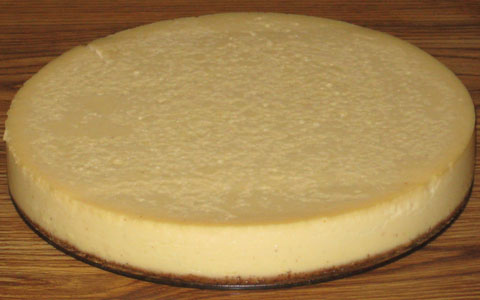
Baked Eggnog Cheesecake—Prototype 18:
2-to-1 Blend of Yogurt Cheese and Cottage Cheese:
Prepare ahead of time 16 ounces of yogurt cheese, derived from one 32-ounce
container of nonfat yogurt. If the resulting yogurt cheese falls below 16
ounces, add back enough of the whey (that was strained out from the yogurt) to
make up the difference. To this yogurt cheese combine 8 ounces (1 cup) of
whipped, lowfat cottage cheese.
Crust:
1 oz. melted, white chocolate
1/2 cup (4 oz.) 2-to-1 blend of yogurt cheese and cottage cheese (see above)
2 tablespoons granulated sugar
1 1/3 tablespoons brown sugar
1 teaspoon cinnamon
1/4 teaspoon vanilla
1.1 oz. Bran Buds, ground up
Pour this crust mixture into pan (9 to 9 1/2 inches) and pre-bake without tub at
300 degrees for 5 minutes, then cool enough to comfortably touch at least the
pan's upper sidewall.
Batter:
2 tablespoons butter, softened or melted
2/3 cup granulated sugar
1 teaspoon rum extract
1 teaspoon vanilla extract
2 1/2 cups (20 oz.) 2-to-1 blend of yogurt cheese and cottage cheese (see above)
2 cups light eggnog
2 tablespoons all-purpose flour
3/8 cup arrowroot
1/4 teaspoon salt
1/2 teaspoon nutmeg
2 eggs
Bake, with tub, for about 90 minutes at 300 degrees. Next, turn oven off,
leaving cheesecake in it (still in tub as well), with oven's door slightly ajar,
for another 45 minutes. Afterwards, remove cheesecake from oven and tub, and let
this cool off (cheesecake still in pan) for about 90 minutes. Then remove from
pan and refrigerate.
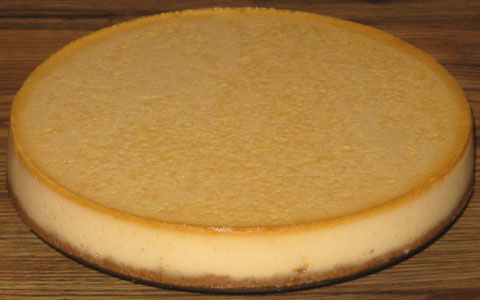
Baked Eggnog Cheesecake—Prototype 19:
2-to-1 Blend of Yogurt Cheese and Cottage Cheese:
Prepare ahead of time 16 ounces of yogurt cheese, derived from one 32-ounce
container of nonfat yogurt. If the resulting yogurt cheese falls below 16
ounces, add back enough of the whey (that was strained out from the yogurt) to
make up the difference. To this yogurt cheese combine 8 ounces (1 cup) of
whipped, lowfat cottage cheese.
Crust:
1 oz. melted, white chocolate
1/2 cup (4 oz.) 2-to-1 blend of yogurt cheese and cottage cheese (see above)
2 tablespoons granulated sugar
2 tablespoons brown sugar
1 teaspoon cinnamon
1/2 teaspoon vanilla
1 oz. All-Bran, ground up
Pour this crust mixture into pan (9 to 9 1/2 inches) and pre-bake without tub at
300 degrees for 5 minutes, then cool enough to comfortably touch at least the
pan's upper sidewall.
Batter:
2 tablespoons butter, softened or melted
2/3 cup granulated sugar
1 teaspoon rum extract
1 teaspoon vanilla extract
2 1/2 cups (20 oz.) 2-to-1 blend of yogurt cheese and cottage cheese (see above)
2 cups light eggnog
2 tablespoons all-purpose flour
3/8 cup arrowroot
1/2 teaspoon nutmeg
2 eggs
Bake, with tub, for about 90 minutes at 300 degrees. Next, turn oven off,
leaving cheesecake in it (still in tub as well), with oven's door slightly ajar,
for another 45 minutes. Afterwards, remove cheesecake from oven and tub, and let
this cool off (cheesecake still in pan) for about 90 minutes. Then remove from
pan and refrigerate. Note: See comments below for more information
in regard to cooking and cooling times.
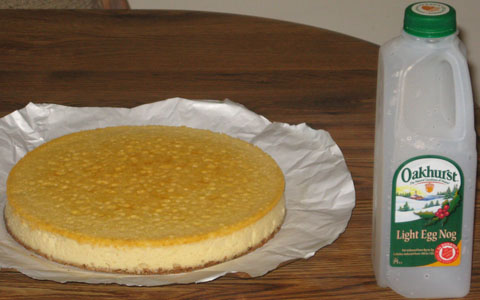
Baked Eggnog Cheesecake—Prototype 20:
Repeat
Prototype 19,
but boost the batter's arrowroot by 2 tablespoons, to 1/2 cup.
Baked Eggnog Cheesecake—Prototype 21:
Batter:
2 cups (16 ounces) lowfat cottage cheese, whipped
4 ounces Neufchatel cheese ("light cream cheese"), softened
5/8 cup (1/2 cup plus 2 tablespoons) granulated sugar
1 teaspoon vanilla extract
1 teaspoon rum extract
1/2 teaspoon nutmeg
2 cups light eggnog
7 tablespoons (1/2 cup less 1 tablespoon) arrowroot
2 eggs
Place into greased 13" x 9" pan (such as a "Pyrex" glass
type), bake in tub at 300 degrees for 120 minutes, shut oven off, leaving door
slightly ajar, for 60 minutes, remove pan containing cheesecake from tub and
oven and let cool at room temperature for 120 minutes, then (with cheesecake
still in pan) refrigerate.
Baked Eggnog Cheesecake—Prototype 22:
3-Cheese Blend (1CT-1NC-4YG):
Prepare ahead of time 16 ounces of yogurt cheese, derived from one 32-ounce
container of nonfat yogurt. If the resulting yogurt cheese falls below 16
ounces, add back enough of the whey (that was strained out from the yogurt) to
make up the difference. To this yogurt cheese combine 4 ounces of whipped,
lowfat cottage cheese and 4 ounces of softened Neufchatel cheese ("light
cream cheese"). All this should yield 24 ounces (about 3 cups).
Batter:
24 oz. (about 3 cups) 3-cheese blend (see above)
3/4 cup granulated sugar
1 teaspoon vanilla extract
1 teaspoon rum extract
1/2 teaspoon nutmeg
2 1/3 cups light eggnog
1/2 cup arrowroot
3 eggs
Place into greased 13" x 9" glass ("Pyrex") pan, bake in tub
at 300 degrees for 90-100 minutes, shut oven off, leaving door slightly ajar, for 60
minutes, remove pan containing cheesecake from tub and oven and let cool at room
temperature for 90-100 minutes, then (with cheesecake still in pan) refrigerate.
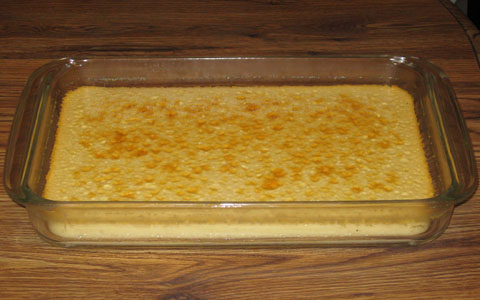
Baked Eggnog Cheesecake—Prototype 23:
2-to-1 Blend of Yogurt Cheese and Cottage Cheese (1CT-2YG [1 part cottage
cheese, 2 parts yogurt cheese]):
Prepare ahead of time 16 ounces of yogurt cheese, derived from one 32-ounce
container of nonfat yogurt. If the resulting yogurt cheese falls below 16
ounces, add back enough of the whey (that was strained out from the yogurt) to
make up the difference. To this yogurt cheese combine 8 ounces (1 cup) of
whipped, lowfat cottage cheese.
Batter:
24 oz. (about 3 cups) 2-to-1 blend of yogurt cheese and cottage cheese (see
above)
3/4 cup granulated sugar
1 teaspoon vanilla extract
1 teaspoon rum extract
1/2 teaspoon nutmeg
2 1/3 cups light eggnog
1 tablespoon xanthan gum
3 eggs
Place into greased 13" x 9" glass ("Pyrex") pan, and bake
in tub at 300 degrees for 80-90 minutes. Shut off oven afterwards, leaving door
slightly ajar, for 60 minutes. Next, remove pan containing cheesecake from tub
and oven, and let cool at room temperature for 90-120 minutes, then (with
cheesecake still in pan) refrigerate.
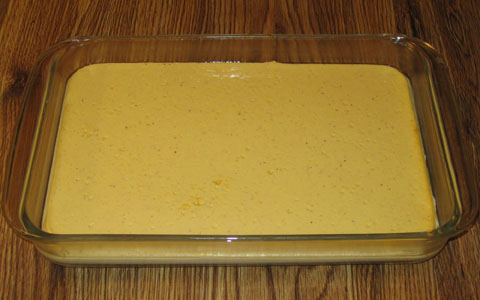
Baked Eggnog Cheesecake—Prototype 24:
2-to-1 Blend of Yogurt Cheese and Cottage Cheese (1CT-2YG):
Prepare ahead of time 16 ounces of yogurt cheese, derived from one 32-ounce
container of nonfat yogurt. If the resulting yogurt cheese falls below 16
ounces, add back enough of the whey (that was strained out from the yogurt) to
make up the difference. To this yogurt cheese combine 8 ounces (1 cup) of
whipped, lowfat cottage cheese.
Batter:
24 oz. (about 3 cups) 2-to-1 blend of yogurt cheese and cottage cheese (see
above)
3/4 cup granulated sugar
1 teaspoon vanilla extract
1 teaspoon rum extract
1/2 teaspoon nutmeg
2 1/3 cups light eggnog
2 1/2 teaspoons xanthan gum
3 eggs
Place into greased 13" x 9" glass ("Pyrex") pan, and bake
in tub at 300 degrees for 90 minutes. Shut off oven afterwards, leaving door
slightly ajar, for 60 minutes. Next, remove pan containing cheesecake from tub
and oven, and let cool at room temperature for 90 minutes, then (with cheesecake
still in pan) refrigerate.
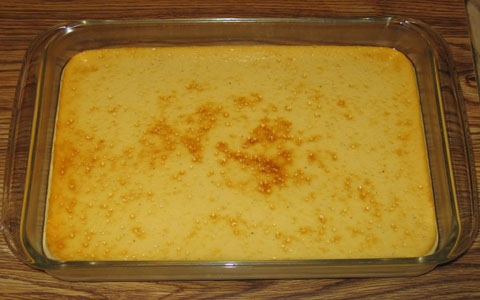
Baked Eggnog Cheesecake—Prototype 25:
2-to-1 Blend of Yogurt Cheese and Cottage Cheese (1CT-2YG):
Prepare ahead of time 16 ounces of yogurt cheese, derived from one 32-ounce
container of nonfat yogurt. If the resulting yogurt cheese falls below 16
ounces, add back enough of the whey (that was strained out from the yogurt) to
make up the difference. To this yogurt cheese combine 8 ounces (1 cup) of
whipped, lowfat cottage cheese.
Batter:
24 oz. (about 3 cups) 2-to-1 blend of yogurt cheese and cottage cheese (see
above)
3/4 cup granulated sugar
1 teaspoon vanilla extract
1 teaspoon rum extract
1/2 teaspoon nutmeg
1 tablespoon xanthan gum
2 cups light eggnog
3 eggs
Place into greased 13" x 9" glass ("Pyrex") pan, and bake
in tub at 300 degrees for 90 minutes. Shut off oven afterwards, leaving door
slightly ajar, for 60 minutes. Next, remove pan containing cheesecake from tub
and oven, and let cool at room temperature for 120 minutes, then (with
cheesecake still in pan) refrigerate.
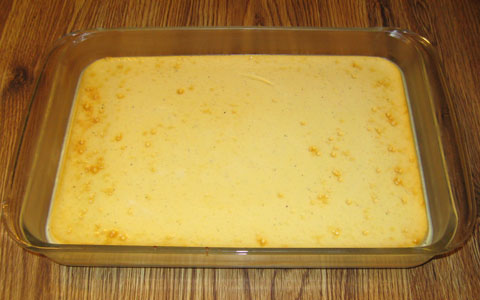
Baked Eggnog Cheesecake—Prototype 26:
2-to-1 Blend of Yogurt Cheese and Cottage Cheese (1CT-2YG):
Prepare ahead of time 16 ounces of yogurt cheese, derived from one 32-ounce
container of nonfat yogurt. If the resulting yogurt cheese falls below 16
ounces, add back enough of the whey (that was strained out from the yogurt) to
make up the difference. To this yogurt cheese combine 8 ounces (1 cup) of
whipped, lowfat cottage cheese.
Batter:
24 oz. (about 3 cups) 2-to-1 blend of yogurt cheese and cottage cheese (see
above)
3/4 cup granulated sugar
1 teaspoon vanilla extract
6/10 (about) teaspoon rum extract (but see comments below)
1/2 teaspoon nutmeg
1 1/3 tablespoons xanthan gum (tip: blend this in before adding the
eggnog)
2 cups light eggnog
3 eggs
Place about 2/3 of this batter into a greased 13" x 9" glass
("Pyrex") pan, and bake in tub at 300 degrees for 70 minutes. After
this is done, remove from oven and carefully add the remaining 1/3
batter on top of the earlier installment. Return to oven and continue baking at
300 degrees for another 80 minutes. Shut off oven afterwards, leaving door
slightly ajar, for 60 minutes. Next, remove pan containing cheesecake from tub
and oven, and let cool at room temperature for 120 minutes, then (with
cheesecake still in pan) refrigerate.
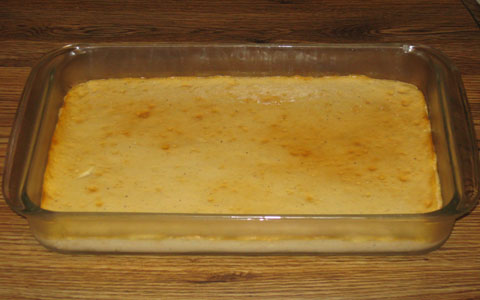
Baked Eggnog Cheesecake—Prototype 27:
Eggnog Concentrate:
Place 2 cups of eggnog into the upper pot of a double-boiler. Very slowly
heat the contents (this can, and probably should, be done on the lowest
burner setting—more importantly, try to get the eggnog's temperature
to settle between 165 and 180 degrees during this process). Stir often,
cooking this eggnog until it is almost down to about 1/4 of its initial
weight. Then let this cool off (at least a little).
Batter:
24 oz. (about 3 cups) whipped, lowfat cottage cheese
3/4 cup granulated sugar
1 teaspoon vanilla extract
1/2 teaspoon nutmeg
Eggnog concentrate (see above)
1 tablespoon xanthan gum
3 eggs
Place into greased 13" x 9" glass ("Pyrex") pan, and bake
in tub at 300 degrees for 90 minutes. Shut off oven afterwards, leaving door
slightly ajar, for 60 minutes. Next, remove pan containing cheesecake from tub
and oven, and let cool at room temperature for 120 minutes, then (with
cheesecake still in pan) refrigerate.
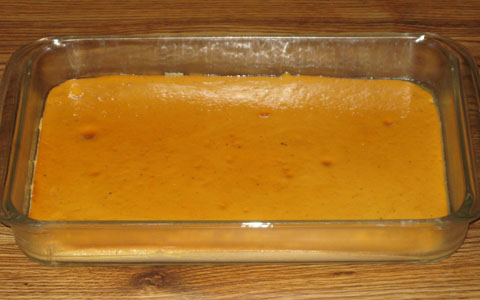
Baked Eggnog Cheesecake—Prototype 28:
Eggnog Concentrate:
Place 2 cups of eggnog into the upper pot of a double-boiler. Very slowly
heat the contents (this can, and probably should, be done on the lowest
burner setting—more importantly, try to get the eggnog's temperature
to settle between 165 and 180 degrees during this process). Stir often,
cooking this eggnog until it is almost down to about 1/3 to 1/4 of its
initial weight. Then let this cool off (at least a little). Tip:
Prepare this concentrate ahead of time. The evaporation process can take
about 7 to 8 hours, depending on the amount of heat applied. Allow
the concentrate to cool down afterwards, then refrigerate until ready for
use.
Batter:
16 oz. (about 2 cups) whipped, lowfat cottage cheese
8 oz. softened Neufchatel cheese ("light cream cheese")
3/4 cup granulated sugar
1 teaspoon vanilla
Eggnog concentrate (see above)
1 teaspoon xanthan gum
3 eggs
Place into greased 13" x 9" glass ("Pyrex") pan, and bake
in tub at 300 degrees for 90 minutes. Shut off oven afterwards, leaving door
slightly ajar, for 60 minutes. Next, remove pan containing cheesecake from tub
and oven, and let cool at room temperature for 120 minutes, then (with
cheesecake still in pan) refrigerate.
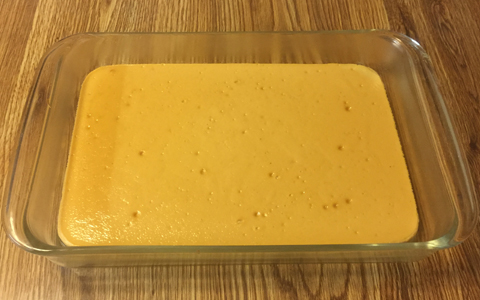
Baked Eggnog Cheesecake—Prototype 29:
Eggnog Concentrate:
Place 2 cups of eggnog into the upper pot of a double-boiler. Very slowly
heat the contents (this can, and probably should, be done on the lowest
burner setting—more importantly, try to get the eggnog's temperature
to settle between 165 and 180 degrees during this process). Stir often,
cooking this eggnog until it is almost down to about 1/3 to 1/4 of its
initial weight. Then let this cool off (at least a little). Tip:
Prepare this concentrate ahead of time. The evaporation process can take
about 7 to 8 hours, depending on the amount of heat applied. Allow
the concentrate to cool down afterwards, then refrigerate until ready for
use.
Batter:
16 oz. (about 2 cups) whipped, lowfat cottage cheese
8 oz. softened Neufchatel cheese ("light cream cheese")
3/4 cup granulated sugar
1 teaspoon vanilla
Eggnog concentrate (see above)
1/2 teaspoon xanthan gum
3 eggs
Place into greased 13" x 9" glass ("Pyrex") pan, and bake
in tub at 300 degrees for 90 minutes. Shut off oven afterwards, leaving door
slightly ajar, for 60 minutes. Next, remove pan containing cheesecake from tub
and oven, and let cool at room temperature for 120 minutes, then (with
cheesecake still in pan) refrigerate.
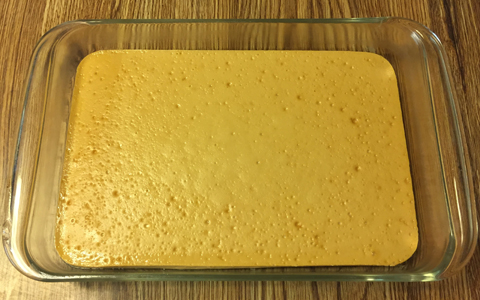
Baked Eggnog Cheesecake—Prototype 30:
Crust:
2 oz. melted, white chocolate
8 oz. (about 1 cup) whipped, lowfat cottage cheese
1/4 cup granulated sugar
1/4 cup brown sugar
1/2 teaspoon vanilla
3 oz. graham crackers, ground up
Place the resulting mixture into a greased 13" x 9" glass
("Pyrex") pan and pre-bake without tub at 300 degrees for 25 minutes,
then remove from oven (cooling off is optional here).
Batter:
16 oz. (about 2 cups) whipped, lowfat cottage cheese
8 oz. softened Neufchatel cheese ("light cream cheese")
3/4 cup granulated sugar
1 teaspoon vanilla
2 cups light eggnog (such as Hood)
1 1/2 teaspoons xanthan gum
3 eggs
Expect close to 6 cups of the resulting batter, but do not add this to
the pan all at once. Rather, this needs to be done in four
installments.
For each of the first three installments, gently scoop about 1 1/2 cups of
batter into the pan, fully covering the surface (here's a tip—scoop small
amounts of batter into scattered places throughout the pan, letting this batter
fill in nearby gaps, and if any of these remain, use a rubber spatula and
gently spread the batter to cover these gaps up), and then bake this pan with
its contents for 25 minutes, at 325 degrees. However, at the end of the third
installment's 25 minutes, add on another 30 minutes of baking time, but only at
300 degrees (that's a 55 minute "baking installment"—the first
25 minutes at 325 degrees and the next 30 at 300). For all four installments,
bake with the pan in a tub filled with at least 1/4 to 1/2 inch of boiling
water.
After the first three installments are done, there should be about 1 1/2 cups of
batter left, with 105 minutes of baking time reached at this point (25 minutes
for each of the first two installments, and 55 for the third one). Now comes the
fourth installment—carefully add the last of this batter on top of the
pan's earlier installments, fully coating the entire surface. Next, return the
entire pan-and-tub assembly to the oven, with the temperature remaining at 300
degrees. Resume baking for another 90 minutes.
Afterward, shut the oven off, and leave its door slightly ajar, with the
cheesecake still inside—and in the tub—for an hour. Next, remove the
cheesecake from the oven and tub. Continue to cool it down at room temperature
for another 120 minutes, then (with cheesecake still in pan) refrigerate.
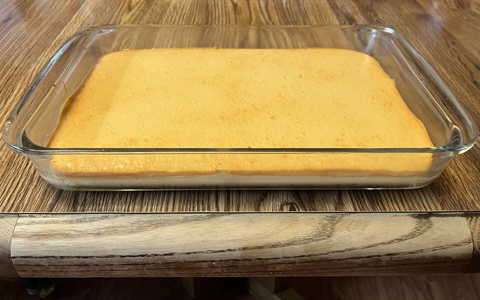
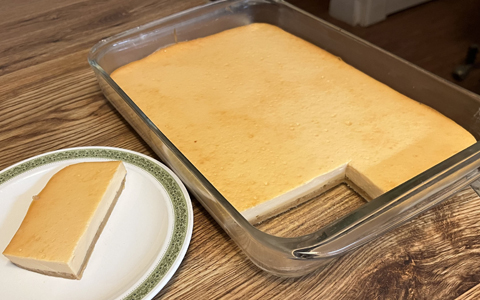
Baked Eggnog Cheesecake—Prototype 31:
Crust:
2 oz. melted, white chocolate
8 oz. (about 1 cup) whipped, lowfat cottage cheese
1/4 cup granulated sugar
1 tablespoon brown sugar
1 teaspoon cinnamon
1/2 teaspoon vanilla
3 oz. graham crackers, ground up (if these are cinnamon-flavored, omit the cinnamon shown above)
Place the resulting mixture into a greased 13" x 9" glass
("Pyrex") pan and pre-bake without tub at 300 degrees for 25 minutes,
then remove from oven (cooling off is optional here).
Batter:
16 oz. (about 2 cups) whipped, lowfat cottage cheese
8 oz. softened Neufchatel cheese ("light cream cheese")
3/4 cup granulated sugar
1 teaspoon vanilla
2 cups light eggnog (such as Hood)
1 teaspoon xanthan gum
3 eggs
Expect close to 6 cups of the resulting batter, but do not add this to
the pan all at once. Rather, this needs to be done in four
installments.
For each of the first three installments, gently scoop about 1 1/2 cups of
batter into the pan, fully covering the surface (here's a tip—scoop small
amounts of batter into scattered places throughout the pan, letting this batter
fill in nearby gaps, and if any of these remain, use a rubber spatula and
gently spread the batter to cover these gaps up), and then bake this pan with
its contents for 25 minutes, at 325 degrees. However, at the end of the third
installment's 25 minutes, add on another 30 minutes of baking time, but only at
300 degrees (that's a 55 minute "baking installment"—the first
25 minutes at 325 degrees and the next 30 at 300). For all four installments,
bake with the pan in a tub filled with at least 1/4 to 1/2 inch of boiling
water.
After the first three installments are done, there should be about 1 1/2 cups of
batter left, with 105 minutes of baking time reached at this point (25 minutes
for each of the first two installments, and 55 for the third one). Now comes the
fourth installment—carefully add the last of this batter on top of the
pan's earlier installments, fully coating the entire surface. Next, return the
entire pan-and-tub assembly to the oven, with the temperature remaining at 300
degrees. Resume baking for another 60 minutes.
Afterward, shut the oven off, and leave its door slightly ajar, with the
cheesecake still inside—and in the tub—for an hour. Next, remove the
cheesecake from the oven and tub. Continue to cool it down at room temperature
for another 120 minutes, then (with cheesecake still in pan) refrigerate.
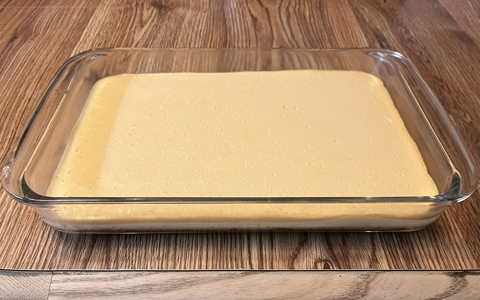
Baked Eggnog Cheesecake—Prototype 32:
Crust:
2 oz. melted, white chocolate
8 oz. (about 1 cup) whipped, lowfat cottage cheese
1/4 cup granulated sugar
1 tablespoon brown sugar
1 teaspoon cinnamon
1/2 teaspoon vanilla
3 oz. graham crackers, ground up (if these are cinnamon-flavored, omit the cinnamon shown above)
Place the resulting mixture into a greased 13" x 9" glass
("Pyrex") pan and pre-bake without tub at 300 degrees for 25 minutes,
then remove from oven (cooling off is optional here).
Batter:
16 oz. (about 2 cups) whipped, lowfat cottage cheese
8 oz. softened Neufchatel cheese ("light cream cheese")
3/4 cup granulated sugar
1 teaspoon vanilla
1 teaspoon rum extract
1/2 teaspoon nutmeg
2 cups light eggnog (such as Hood)
1 teaspoon xanthan gum
3 eggs
Expect close to 6 cups of the resulting batter, but do not add this to
the pan all at once. Rather, this needs to be done in four
installments.
For each of the first three installments, gently scoop about 1 1/2 cups of
batter into the pan, fully covering the surface (here's a tip—scoop small
amounts of batter into scattered places throughout the pan, letting this batter
fill in nearby gaps, and if any of these remain, use a rubber spatula and
gently spread the batter to cover these gaps up), and then bake this pan with
its contents for 25 minutes, at 325 degrees*. However, at the end of the third
installment's 25 minutes, add on another 10 minutes of baking time, but only at
300 degrees (that's a 35 minute "baking installment"—the first
25 minutes at 325 degrees and the next 10 at 300). For all four installments,
bake with the pan in a tub filled with at least 1/4 to 1/2 inch of boiling
water.
* (The temperature for the first installment ended up unintentionally at 345
degrees. To compensate for this error, the temperature for the second installment
was set to 315 degrees. See comments below for more details.)
After the first three installments are done, there should be about 1 1/2 cups of
batter left, with 85 minutes of baking time reached at this point (25 minutes
for each of the first two installments, and 35 for the third one). Now comes the
fourth installment—carefully add the last of this batter on top of the
pan's earlier installments, fully coating the entire surface. Next, return the
entire pan-and-tub assembly to the oven, with the temperature remaining at 300
degrees. Resume baking for another 50 minutes.
Afterward, shut the oven off, and leave its door slightly ajar, with the
cheesecake still inside—and in the tub—for an hour. Next, remove the
cheesecake from the oven and tub. Continue to cool it down at room temperature
for another 120 minutes, then (with cheesecake still in pan) refrigerate.
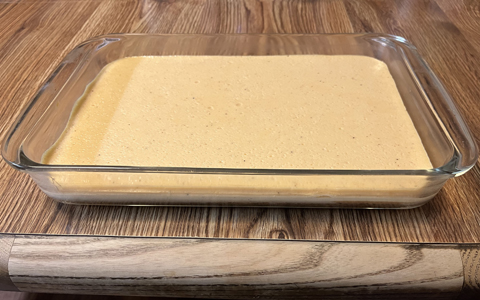
Baked Eggnog Cheesecake—Prototype 33:
Crust:
2 oz. melted, white chocolate
8 oz. (about 1 cup) whipped, lowfat cottage cheese
1/4 cup granulated sugar
1 tablespoon brown sugar
1 teaspoon cinnamon
1/2 teaspoon vanilla
3 oz. graham crackers, ground up (if these are cinnamon-flavored, omit the cinnamon shown above)
Place the resulting mixture into a greased 13" x 9" glass
("Pyrex") pan and pre-bake without tub at 300 degrees for 30 minutes,
then remove from oven (cooling off is optional here).
Batter:
16 oz. (about 2 cups) whipped, lowfat cottage cheese
8 oz. softened Neufchatel cheese ("light cream cheese")
3/4 cup granulated sugar
1 teaspoon vanilla
1/2 teaspoon rum extract
1/2 teaspoon nutmeg
2 cups light eggnog (such as Hood)
3/4 teaspoon xanthan gum
3 eggs
Expect close to 6 cups of the resulting batter, but do not add this to
the pan all at once. Rather, this needs to be done in four
installments.
For each of the first three installments, gently scoop about 1 1/2 cups of
batter into the pan, fully covering the surface (here's a tip—scoop small
amounts of batter into scattered places throughout the pan, letting this batter
fill in nearby gaps, and if any of these remain, use a rubber spatula and
gently spread the batter to cover these gaps up), and then bake this pan with
its contents for 25 minutes, at 325 degrees. However, at the end of the third
installment's 25 minutes, add on another 10 minutes of baking time, but only at
300 degrees (that's a 35 minute "baking installment"—the first
25 minutes at 325 degrees and the next 10 at 300). For all four installments,
bake with the pan in a tub filled with at least 1/4 to 1/2 inch of boiling
water.
After the first three installments are done, there should be about 1 1/2 cups of
batter left, with 85 minutes of baking time reached at this point (25 minutes
for each of the first two installments, and 35 for the third one). Now comes the
fourth installment—carefully add the last of this batter on top of the
pan's earlier installments, fully coating the entire surface. Next, return the
entire pan-and-tub assembly to the oven, with the temperature remaining at 300
degrees. Resume baking for another 40 minutes.
Afterward, shut the oven off, and leave its door slightly ajar, with the
cheesecake still inside—and in the tub—for an hour. Next, remove the
cheesecake from the oven and tub. Continue to cool it down at room temperature
for another 120 minutes, then (with cheesecake still in pan) refrigerate.
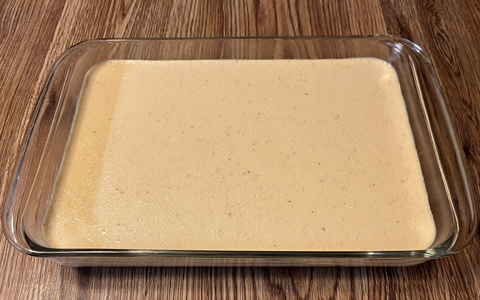
|
|

|